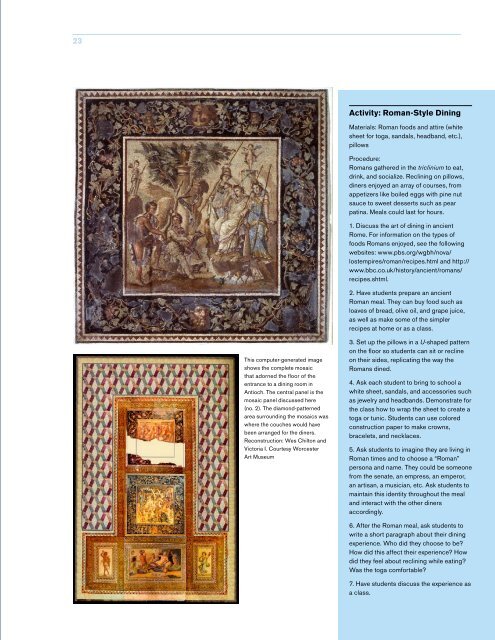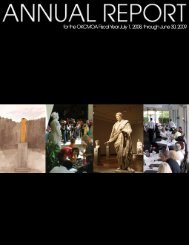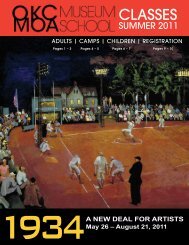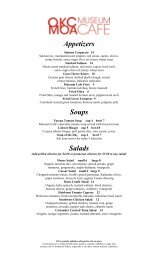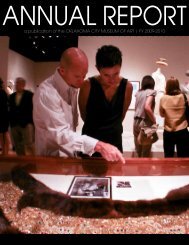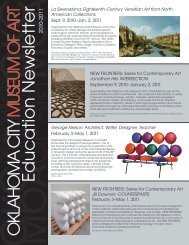Roman Art from the Louvre Educators' Resource Guide
Roman Art from the Louvre Educators' Resource Guide
Roman Art from the Louvre Educators' Resource Guide
Create successful ePaper yourself
Turn your PDF publications into a flip-book with our unique Google optimized e-Paper software.
23<br />
Activity: <strong>Roman</strong>-Style Dining<br />
Materials: <strong>Roman</strong> foods and attire (white<br />
sheet for toga, sandals, headband, etc.),<br />
pillows<br />
Procedure:<br />
<strong>Roman</strong>s ga<strong>the</strong>red in <strong>the</strong> triclinium to eat,<br />
drink, and socialize. Reclining on pillows,<br />
diners enjoyed an array of courses, <strong>from</strong><br />
appetizers like boiled eggs with pine nut<br />
sauce to sweet desserts such as pear<br />
patina. Meals could last for hours.<br />
1. Discuss <strong>the</strong> art of dining in ancient<br />
Rome. For information on <strong>the</strong> types of<br />
foods <strong>Roman</strong>s enjoyed, see <strong>the</strong> following<br />
websites: www.pbs.org/wgbh/nova/<br />
lostempires/roman/recipes.html and http://<br />
www.bbc.co.uk/history/ancient/romans/<br />
recipes.shtml.<br />
2. Have students prepare an ancient<br />
<strong>Roman</strong> meal. They can buy food such as<br />
loaves of bread, olive oil, and grape juice,<br />
as well as make some of <strong>the</strong> simpler<br />
recipes at home or as a class.<br />
This computer-generated image<br />
shows <strong>the</strong> complete mosaic<br />
that adorned <strong>the</strong> floor of <strong>the</strong><br />
entrance to a dining room in<br />
Antioch. The central panel is <strong>the</strong><br />
mosaic panel discussed here<br />
(no. 2). The diamond-patterned<br />
area surrounding <strong>the</strong> mosaics was<br />
where <strong>the</strong> couches would have<br />
been arranged for <strong>the</strong> diners.<br />
Reconstruction: Wes Chilton and<br />
Victoria I. Courtesy Worcester<br />
<strong>Art</strong> Museum<br />
3. Set up <strong>the</strong> pillows in a U-shaped pattern<br />
on <strong>the</strong> floor so students can sit or recline<br />
on <strong>the</strong>ir sides, replicating <strong>the</strong> way <strong>the</strong><br />
<strong>Roman</strong>s dined.<br />
4. Ask each student to bring to school a<br />
white sheet, sandals, and accessories such<br />
as jewelry and headbands. Demonstrate for<br />
<strong>the</strong> class how to wrap <strong>the</strong> sheet to create a<br />
toga or tunic. Students can use colored<br />
construction paper to make crowns,<br />
bracelets, and necklaces.<br />
5. Ask students to imagine <strong>the</strong>y are living in<br />
<strong>Roman</strong> times and to choose a “<strong>Roman</strong>”<br />
persona and name. They could be someone<br />
<strong>from</strong> <strong>the</strong> senate, an empress, an emperor,<br />
an artisan, a musician, etc. Ask students to<br />
maintain this identity throughout <strong>the</strong> meal<br />
and interact with <strong>the</strong> o<strong>the</strong>r diners<br />
accordingly.<br />
6. After <strong>the</strong> <strong>Roman</strong> meal, ask students to<br />
write a short paragraph about <strong>the</strong>ir dining<br />
experience. Who did <strong>the</strong>y choose to be?<br />
How did this affect <strong>the</strong>ir experience? How<br />
did <strong>the</strong>y feel about reclining while eating?<br />
Was <strong>the</strong> toga comfortable?<br />
7. Have students discuss <strong>the</strong> experience as<br />
a class.


